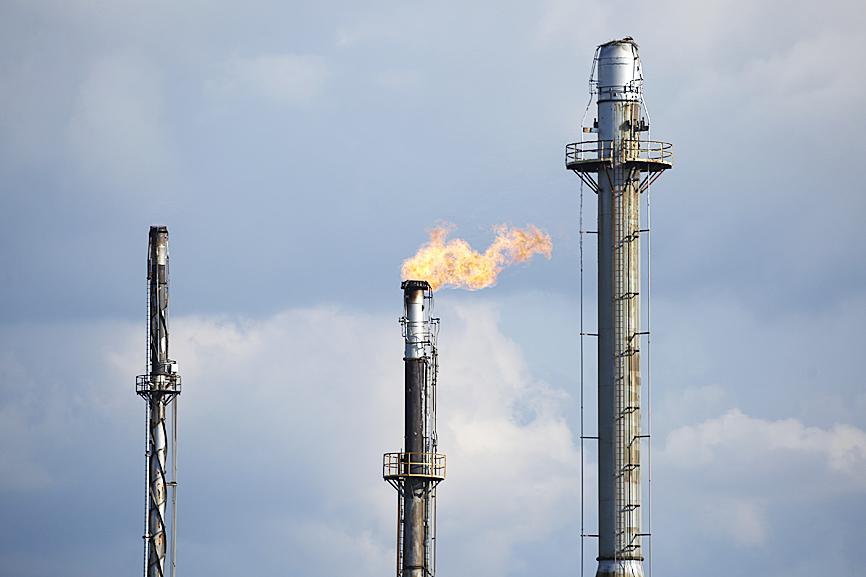Oil posted a gain last month, boosted by a steadily weakening US dollar and OPEC’s restraint on production.
Deep crude output curbs by the OPEC and its allies have helped futures rebound from their plunge below zero in April, yet the unprecedented cuts are set to ease in a matter of days.
On Friday, crude oil recovered from an overnight slump, with Brent crude for August delivery rising 0.84 percent to 43.52 a barrel, an increase of 0.42 percent from a week earlier. West Texas intermediate for July delivery added 0.88 percent to US$40.27 per barrel, but dropped 2.28 percent for the week.

Photo: Bloomberg
Still, US crude inventories have showed signs of shrinking and are sitting at the lowest since April. The Bloomberg Dollar Spot Index is also set for its worst monthly performance since January 2018, bolstering the appeal of commodities traded in the US currency.
“There was a pretty significant drop in crude oil inventory and OPEC and some of the refiners are doing a good job of rebalancing the market,” said Phil Streible, chief market strategist at Blue Line Futures LLC in Chicago. “The decline in the dollar has also helped support crude oil.”
Yet, futures have remained trapped in a tight trading range with rallies limited by the COVID-19 pandemic ravaging demand.
Exxon Mobil Corp said that it only sees an oil consumption recovery well into next year.
Adding to troubling signs over an economic recovery, US consumer sentiment extended its slide late last month as the virus led to renewed business closings and layoffs. Exxon and Chevron Corp posted the worst losses in a generation as the virus, combined with a global crude glut, battered their businesses.
Meanwhile, US shale producers are also saying that supply is likely to come roaring back over the next few months with futures near US$40 a barrel.
ConocoPhillips this week said that by September it would restart most wells that were shut.
“The big worry is that we’re about to go into August and this is the last two weeks or so of potential driving vacations,” said Bill O’Grady, executive vice president at Confluence Investment Management in St Louis, Missouri. “You’ve had depressed demand for gasoline and it’s probably not going to get a whole lot better from here.”
OPEC+ plans to return about 1.5 million barrels a day to the market next month after cutting global supply by about 10 percent when demand plunged.
Additional reporting by staff writer

Among the rows of vibrators, rubber torsos and leather harnesses at a Chinese sex toys exhibition in Shanghai this weekend, the beginnings of an artificial intelligence (AI)-driven shift in the industry quietly pulsed. China manufactures about 70 percent of the world’s sex toys, most of it the “hardware” on display at the fair — whether that be technicolor tentacled dildos or hyper-realistic personalized silicone dolls. Yet smart toys have been rising in popularity for some time. Many major European and US brands already offer tech-enhanced products that can enable long-distance love, monitor well-being and even bring people one step closer to

TRANSFORMATION: Taiwan is now home to the largest Google hardware research and development center outside of the US, thanks to the nation’s economic policies President Tsai Ing-wen (蔡英文) yesterday attended an event marking the opening of Google’s second hardware research and development (R&D) office in Taiwan, which was held at New Taipei City’s Banciao District (板橋). This signals Taiwan’s transformation into the world’s largest Google hardware research and development center outside of the US, validating the nation’s economic policy in the past eight years, she said. The “five plus two” innovative industries policy, “six core strategic industries” initiative and infrastructure projects have grown the national industry and established resilient supply chains that withstood the COVID-19 pandemic, Tsai said. Taiwan has improved investment conditions of the domestic economy

Malaysia’s leader yesterday announced plans to build a massive semiconductor design park, aiming to boost the Southeast Asian nation’s role in the global chip industry. A prominent player in the semiconductor industry for decades, Malaysia accounts for an estimated 13 percent of global back-end manufacturing, according to German tech giant Bosch. Now it wants to go beyond production and emerge as a chip design powerhouse too, Malaysian Prime Minister Anwar Ibrahim said. “I am pleased to announce the largest IC (integrated circuit) Design Park in Southeast Asia, that will house world-class anchor tenants and collaborate with global companies such as Arm [Holdings PLC],”

MAJOR BENEFICIARY: The company benefits from TSMC’s advanced packaging scarcity, given robust demand for Nvidia AI chips, analysts said ASE Technology Holding Co (ASE, 日月光投控), the world’s biggest chip packaging and testing service provider, yesterday said it is raising its equipment capital expenditure budget by 10 percent this year to expand leading-edge and advanced packing and testing capacity amid strong artificial intelligence (AI) and high-performance computing chip demand. This is on top of the 40 to 50 percent annual increase in its capital spending budget to more than the US$1.7 billion to announced in February. About half of the equipment capital expenditure would be spent on leading-edge and advanced packaging and testing technology, the company said. ASE is considered by analysts